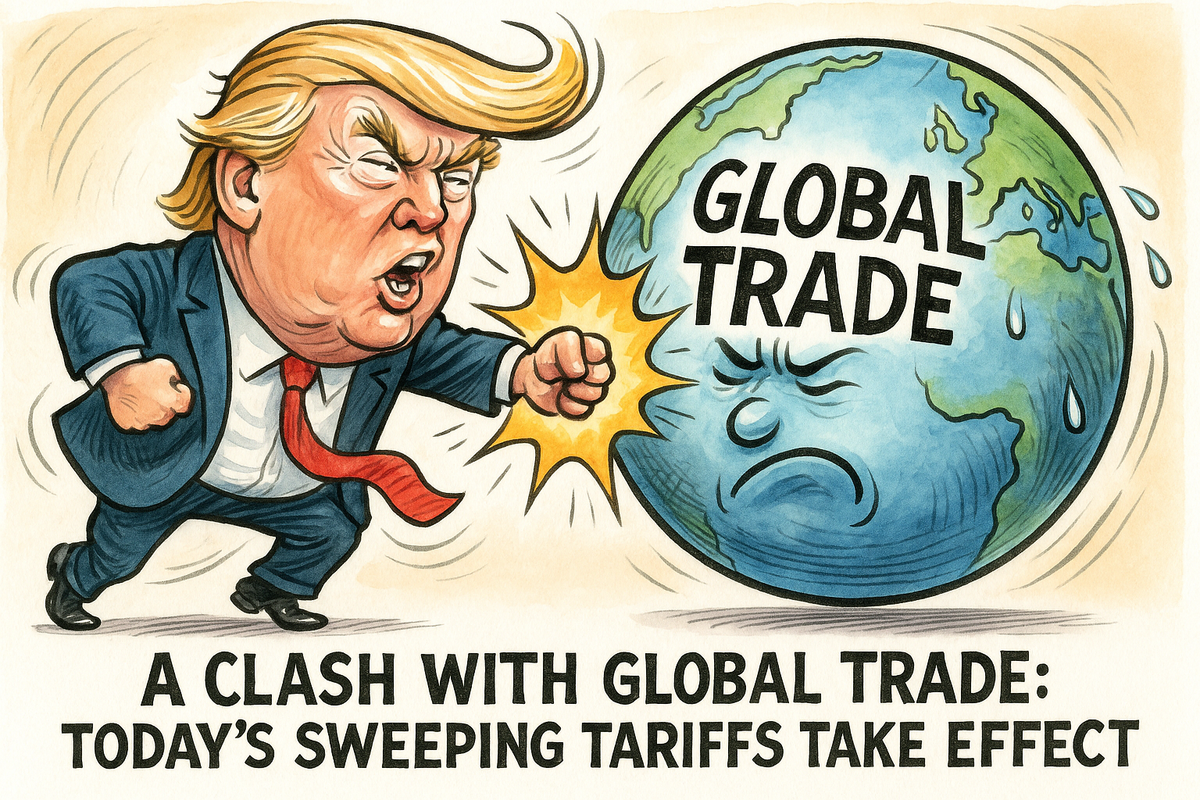Trump’s Tariff Tsunami: How a 100% Chip Duty and Record-High Import Taxes Are Rewriting Global Trade
Just after midnight, President Donald Trump implemented a wave of new tariffs across goods imported from over 60 countries.-Rafael Benavente

By Rafael Benavente
A Clash with Global Trade: Today’s Sweeping Tariffs Take Effect
August 7, 2025 marks a pivotal moment in U.S. trade history. Just after midnight, President Donald Trump implemented a wave of new tariffs across goods imported from over 60 countries. Applied immediately, these tariffs represent the highest average import tax level seen in the United States since 1934, with U.S. consumers now facing an average cost increase of 18.3% on imported products, according to the Budget Lab at Yale—a nonpartisan research entity AP News+1.
Breakdown by Region and Product:
- 10% or more: Applies broadly to goods from more than 60 nations.
- 15% tariffs: Targeted at imports from the EU, Japan, and South Korea.
- 20% tariffs: Hit products from Taiwan, Vietnam, and Bangladesh.
- South Africa: Facing 30% on specific exports; the country’s president engaged directly with Trump ahead of implementation AP News+5AP News+5Yahoo Finance+5.
- India: Subject to an added 25% tariff on oil, bringing total tariff exposure to 50%, effective later this month AP News+2AP News+2.
The administration is framing these tariffs as a strategic move to steer the U.S. back toward manufacturing dominance by incentivizing domestic production and investment.
Semiconductor Shock: 100% Tariff—But… A Big Loophole
Perhaps the most dramatic dimension of today's policy is the newly declared 100% tariff on imported semiconductors and computer chips. But the President announced a conditional exemption: companies committing to build chip facilities in the U.S. can avoid the tariff The Washington Post+2AP News+2Yahoo Finance+9AP News+9The Verge+9.
- Apple: Took center stage alongside Trump at the White House. The tech giant secured an exemption by expanding its U.S. investment commitment to $600 billion over coming years, paired with a partnership to shift Corning’s glass production for Apple devices to Kentucky The Verge+8The Washington Post+8Investors+8.
- Market reaction: U.S. chipmakers with domestic production—TSMC, GlobalFoundries, Texas Instruments, and company partners like Broadcom and Applied Materials—saw share prices rise between 1.1% and 8.5%, buoyed by favorable exemption policies Investors+2Reuters+2.
- Industry confusion: Smaller manufacturers—such as Adafruit—are voicing anxiety. They await official guidance on whether embedded chips (e.g., those already built into electronics or autos) will fall under the tariff umbrella Yahoo Finance+7AP News+7The Verge+7.
- Strategic ambiguity: Experts note the tariff may serve as both carrot and stick—pressuring firms to invest domestically, while granting Trump discretionary power to judge exemption eligibility The Washington Post+1.
Market Ripples: Stocks, Retailers, and Consumer Impacts
U.S. Trading Floors Today:
- S&P 500: Slight dip (~0.3%).
- Dow Jones: Fell approximately 0.7%, losing nearly 293 points.
- Nasdaq: Held steady AP News.
Broader Market Reactions:
- Technology and Chips: Beneficiary stocks surged—thanks to exemptions and investment pledges.
- General Consumer Sentiment: Retailers and households are bracing for inflation. With cost pressures rising across numerous sectors—electronics, autos, appliances, clothing—industries anticipate raising prices to compensate.
- Small business concerns: Particularly for those that source chip components as embedded parts, indefinite ambiguity creates planning nightmares and margin pressure AP News+1AP News+4AP News+4The Washington Post+4.
Inflation Outlook:
- Yale’s Budget Lab projected an average 18.3% import cost increase—echoing previous estimates that suggest U.S. households could shoulder approximately $2,400 more in annual expenses AP News+2AP News+2.
Global Fallout: Diplomatic Tensions and Escalation Risks
The widespread tariffs have shocked global actors:
- South Africa: Acting early—its leader engaged in dialogue with Trump to negotiate potential relief from steep new tariffs The Associated Press+12AP News+12AP News+12.
- India: Faces 50% effective tariffs on oil, highlighting trade friction with a key partner AP News.
- Other partners: Countries like Malaysia and the Philippines are at risk—countries dependent on chip exports that may not qualify for U.S. exemptions Reuters+2The Washington Post+2.
- EU & Japan: Previously averaged 15% tariffs—now must weigh whether new chip rules overlap or escalate existing trade barriers AP News.
- Retaliatory posture: While today's flashpoint centers on semiconductors, the broader sweep of tariffs across multiple nations heightens the prospect of retaliatory measures.
Legal Battles: Courts Push Back on Executive Overreach
Trump’s tariff power rests primarily on actions taken under the International Emergency Economic Powers Act (IEEPA)—a focus of recent legal challenges.
- In V.O.S. Selections, Inc. v. United States, the U.S. Court of International Trade ruled on May 28, 2025 that Trump’s “Liberation Day” tariffs exceeded his constitutional authority under IEEPA. The ruling halted enforcement of those tariffs and ordered customs to cease collection Yahoo FinanceWikipedia+2Wikipedia+2.
- The administration’s appeal is currently before the Federal Circuit. Judges heard oral arguments on July 31, 2025, but a final verdict is pending. Meanwhile, the tariffs remain in effect under a stay Wikipedia.
- Observers are closely watching whether today's tariffs, introduced under similar legal reasoning (IEEPA), will invite renewed legal challenges—and whether future court action might again challenge executive overreach.
Political Calculus and Strategic Implications
Domestic Politics:
- Trump’s tariffs reinforce his populist “America First” stance—aiming to reclaim jobs, manufacturing, and political capital.
- High-profile corporate matches (e.g., Apple’s $600 billion investment) serve as political theater for job creation and nationalistic economic strategy.
Trade Policy Strategy:
- The conditional 100% chip tariff acts as leverage—forcing firms to choose between high costs or domestic investment.
- Ambiguity in exemption criteria leaves room for selective enforcement and negotiation.
Risks Ahead:
- Retail stress: Holiday supply chains may be disrupted, with retailers struggling to assess pricing and inventory amid shifting tariffs Wikipedia+2Wikipedia+2InvestorsThe Guardian+8AP News+8The Washington Post+8The Washington Post.
- International retaliation: Allies and trade partners may escalate with tariffs of their own, potentially targeting red‑state industries or employing symbolic resistance.
- Slowed hiring & real‑estate, as noted in AP coverage, signal early domestic economic strain which may undermine policy goals over time WikipediaAP News.
Conclusion: A High-Stakes Gamble on Manufacturing Revival
August 7, 2025 stands as perhaps the most sweeping reassertion of U.S. trade protectionism in nearly a century. With tariffs touching nearly all sectors and regions—from broad import levies to a targeted 100% chip duty—Trump has thrown down a gauntlet.
- Consumers face inflation pressures across a broad array of goods.
- Tech and chip sectors benefit selectively, conditioned on domestic investment.
- Small businesses and global partners grapple with ambiguity and uncertain future.
- Legal challenges loom, with past rulings casting doubt on the long-term viability of broadly wielded executive power in trade.
- Politics and negotiation remain fluid—this is as much a bargaining strategy as a fixed policy.
By Rafael Benavente
